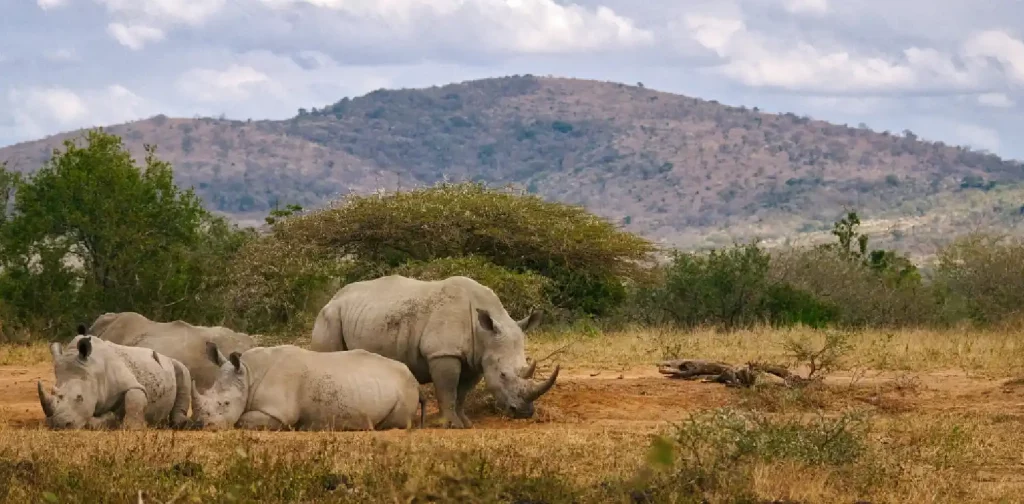Poaching of African Rhinos Increases in South Africa

Photo: Matthias Mullie on Unsplash.
The African continent is known for its rich biodiversity. South Africa is home to various plant and animal species, including the African rhinos. However, poaching has significantly reduced the African rhino population in the country. In a recent update, the government revealed an increase in rhino poaching in South Africa.
African rhinos population
Most African rhinos live in southern African countries, including Namibia, Botswana, Zimbabwe, and South Africa. They play a vital role in shaping and balancing the ecosystems by acting as important grazers. Additionally, rhinos also attract tourists, thus creating job opportunities and generating income for locals.
Unfortunately, the number of African rhinos has been declining over the years. This decline is attributed mainly to poaching, which is the illegal killing and trafficking of wildlife. Rhinos are sought after for their horns, which are used for traditional medicine. The issue was especially prevalent between 2007 and 2014 when the number of African rhinos poached in South Africa spiked from 13 to 1,215.
Increasing poaching cases
In a statement released on February 27, 2024, South Africa’s Department of Forestry, Fisheries, and the Environment revealed increased rhino poaching in the country. The government noted that 499 rhinos were poached across South Africa, 51 more rhinos than the previous year.
“The pressure again has been felt in the KwaZulu-Natal (KZN) province, with Hluhluwe-iMfolozi Park facing the brunt of poaching cases, losing 307 of the total national poaching loss. This is the highest poaching loss within this province,” said Barbara Creecy, the Minister of Forestry, Fisheries, and the Environment of South Africa.
Meanwhile, the Kruger National Park (KNP) recorded 78 poaching cases in 2023, showing a 37% decrease compared to 2022.
The increasing poaching issue happened after some progress was made in 2022. According to the IUCN, there was a 4.2% increase in black rhino and a 5.6% increase in white rhino populations across Africa. This further highlights the urgency to address poaching and other wildlife crimes to create steady, significant progress in wildlife conservation.
Collaboration to combat wildlife crime
One of the keys to combating wildlife crime is through collaboration. In the statement, Minister Creecy further shared that the government is commencing cross-department engagement and strengthening public-private partnerships to address wildlife trafficking.
Furthermore, the Department of Forestry, Fisheries, and the Environment (DFFE) also plans to revise the Black and White Rhinoceros Biodiversity Management Plans (BMP) to enhance the strategic approach and action plan for African rhinos conservation across the country and continent. Ultimately, reducing wildlife crime must also go hand-in-hand with improving biodiversity management for more effective progress in biodiversity protection and preservation.
Editor: Nazalea Kusuma

Join Green Network Asia Membership
If you find this content useful, support Green Network Asia’s movement to create positive impact for people and the planet through public education and multi-stakeholder advocacy on sustainability-related issues and sustainable development. Get exclusive benefits for personal and professional development as well as for organizational capacity development.
Become a Member Now
Kresentia Madina
Madina is the Assistant Manager for Digital Publications at Green Network Asia. She graduated from Universitas Indonesia with a bachelor's degree in English Literature. She has three years of professional experience working on GNA international digital publications, programs, and partnerships particularly on social and cultural issues.


 Prescribing Beyond Profit for CEOs’ Anxiety
Prescribing Beyond Profit for CEOs’ Anxiety  An Interview with May Tan-Mullins, CEO and Provost of University of Reading Malaysia
An Interview with May Tan-Mullins, CEO and Provost of University of Reading Malaysia  An Interview with Eu Chin Fen, CEO of Frasers Hospitality
An Interview with Eu Chin Fen, CEO of Frasers Hospitality  The UK Government’s Funding Package Plan to Tackle Youth Unemployment
The UK Government’s Funding Package Plan to Tackle Youth Unemployment  Understanding the Dark Side of Artificial Intelligence
Understanding the Dark Side of Artificial Intelligence  Attempting Data Center Circularity Through Waste Heat Recovery
Attempting Data Center Circularity Through Waste Heat Recovery